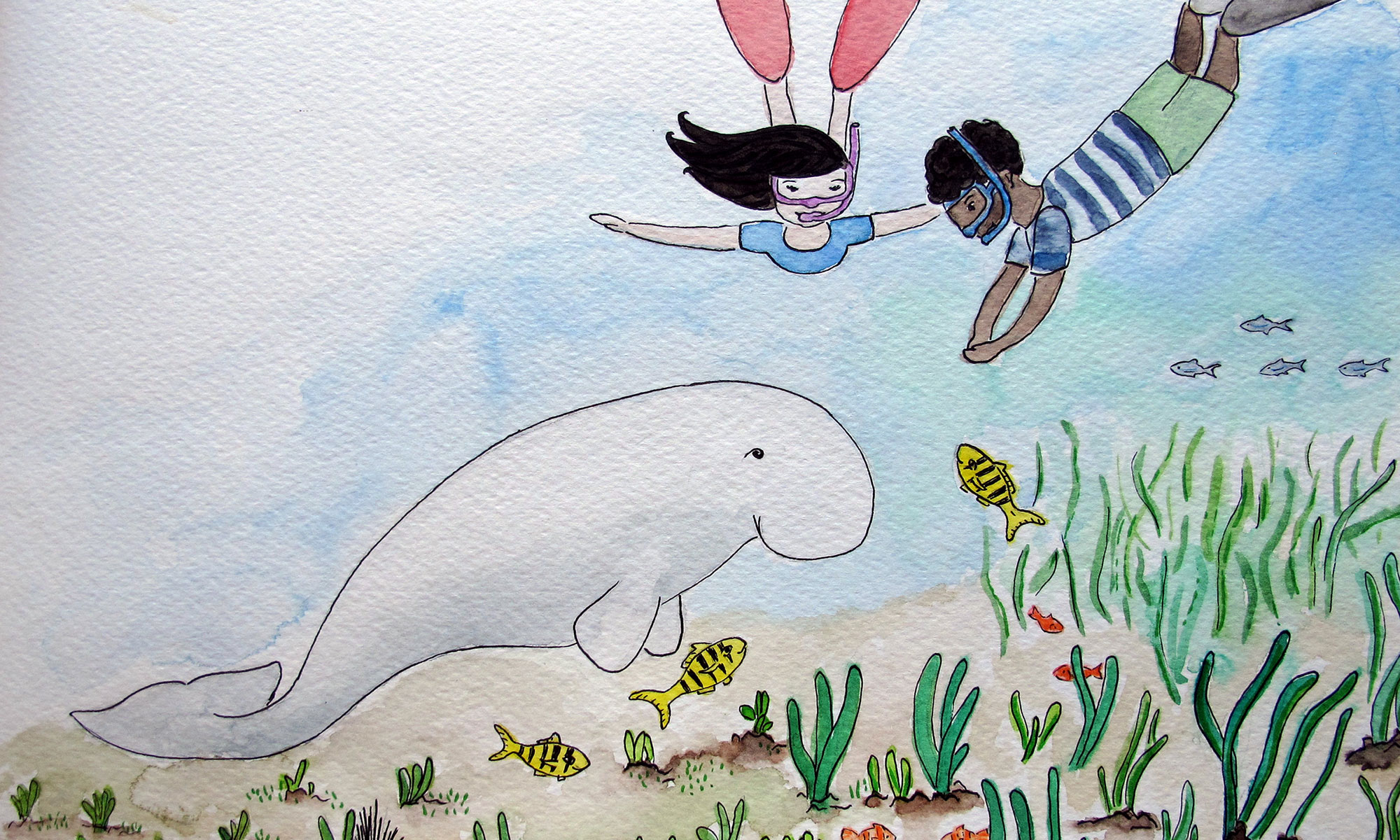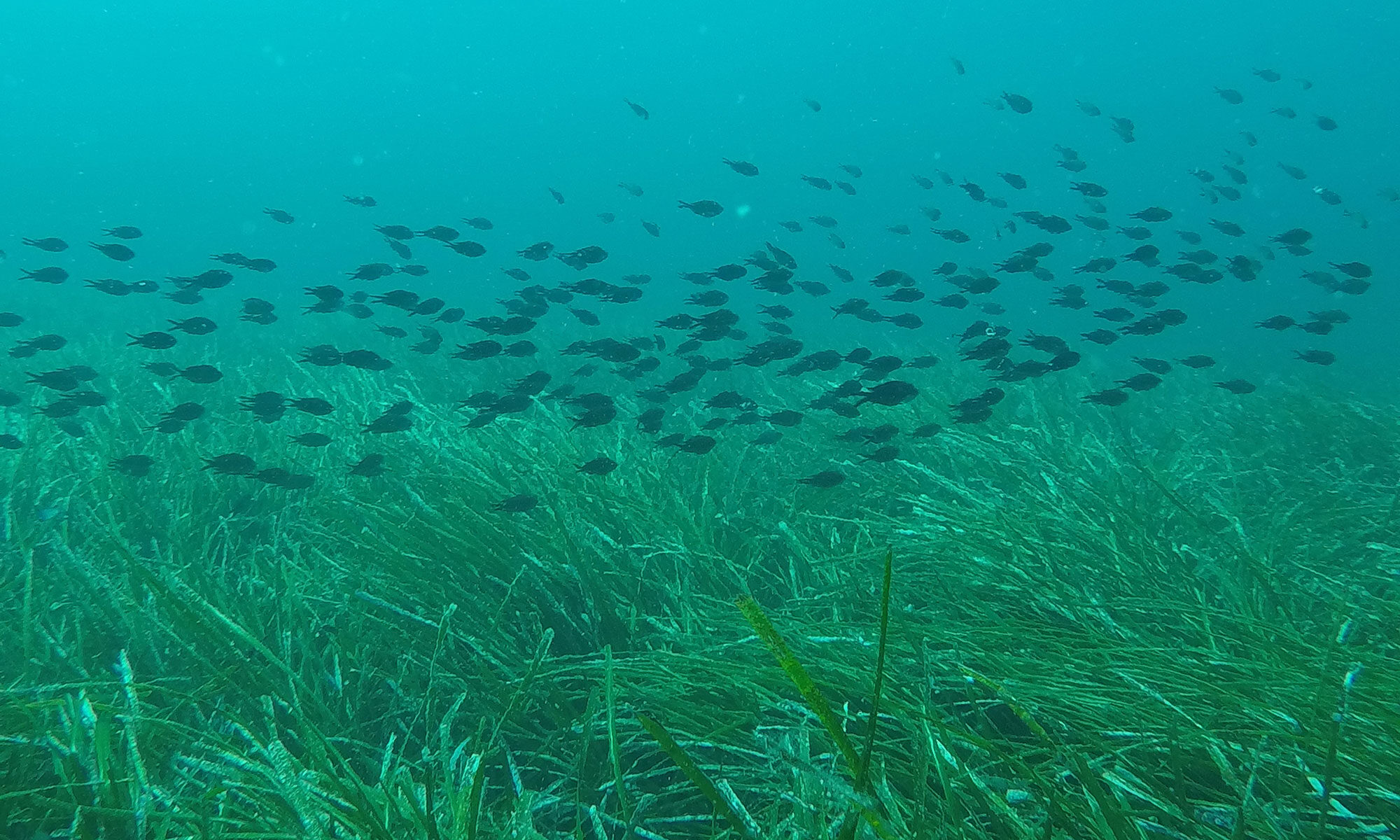What is seagrass?
Seagrasses are not algae! They belong to the flowering plants and their next relatives on land are lilies- beautiful and colourful flowers. Seagrasses are the only flowering plants that can grow in the ocean. Seagrasses have green leaves in different lengths and shapes. Those leaves have veins that run from the leaf tips down to the roots of each plant. Those veins do not carry blood like our veins do, but they do transport nutrients, water and oxygen where they are needed. You can imagine those veins like small highways.
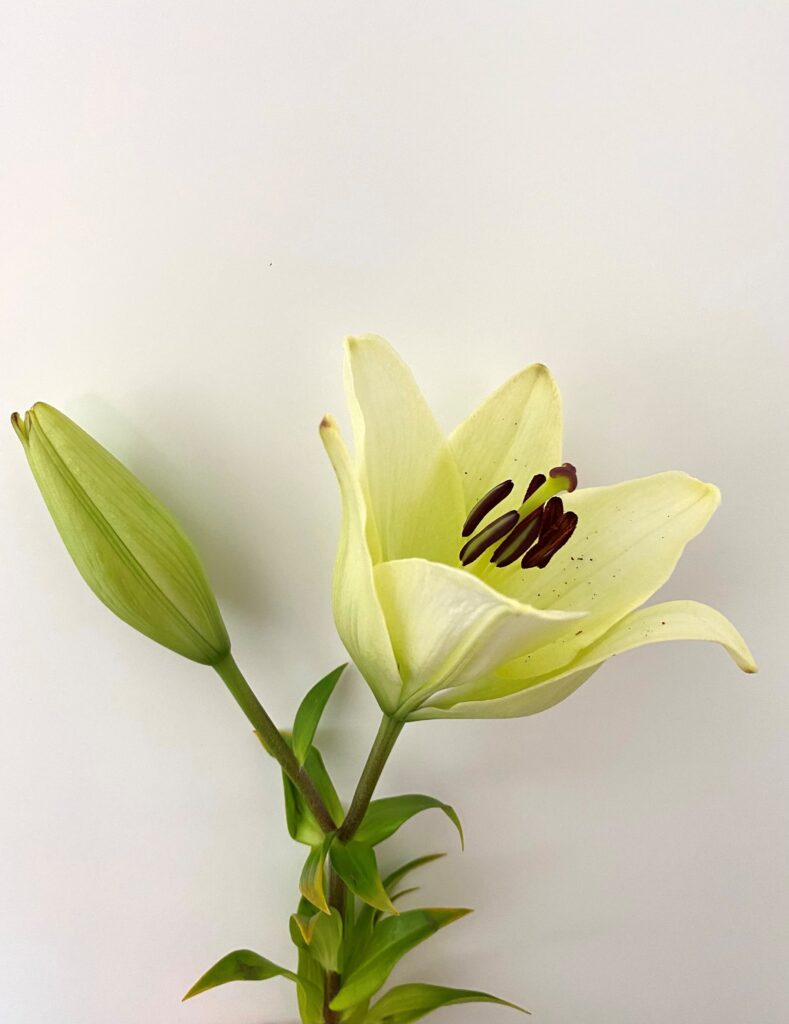
Moreover, seagrasses have thicker stems that run along the seafloor called rhizomes. The leaves from seagrasses branch off those rhizomes into the water column and the roots grow from them into the sediment below the seagrasses. Both- rhizomes and roots- can take up and store nutrients and anchor the seagrass firmly into the seafloor and help the seagrass to not get carried away by waves. Seaweeds and algae do not belong to the actual plants and have a more simple structure. They do not have veins and flowers and only have a root like structure called holdfast, which they use to hold onto rocks or the seafloor.
How do seagrasses actually look like?
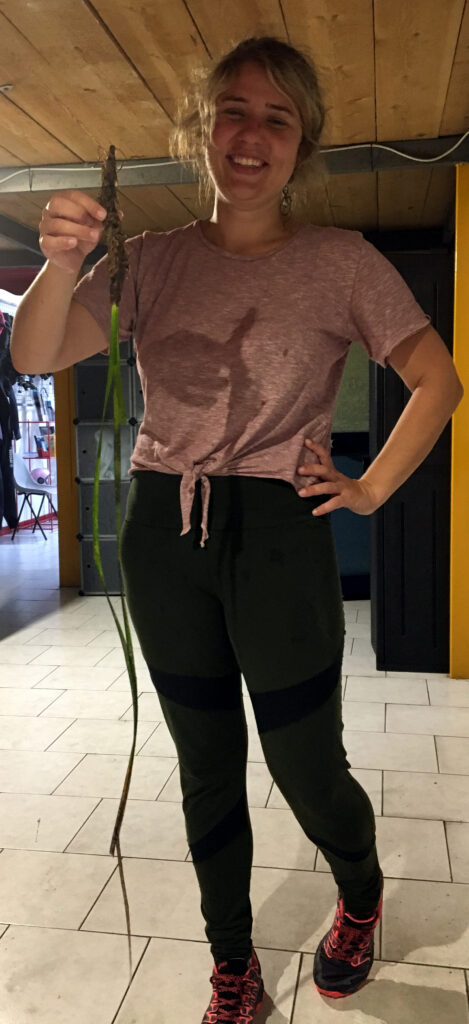
There are actually 72 different seagrass species in the world. There are tiny seagrasses the size of your thumb or seagrasses with giant leaves that are as tall as or even taller than you or your parents (like the Neptune Grass Posidonia oceanica). The different seagrass species come in all shapes you can imagine. Some even look like spaghettis, like the species Syringodium.
Seagrasses can grow on tiny patches or on areas of around 10,000 m²- that is roughly the size of one soccer field and another half one. The biggest seagrass meadow ever seen was growing on an area of 4500km²- that is the size of 630 soccer fields!
Where can you find seagrass meadows?
You can find seagrass meadows at coasts all around the world- except for Antarctica. Seagrasses can grow in warm and cold waters. If the water is clear, they can even form meadows in up to 60m depth. That is because seagrasses need the sunlight to survive. Like the house plants in your flat, they need the help of the energy from the sunlight to make their own “food” (Glucose- a sugar) out of water and carbon dioxide – a process called photosynthesis.
What animals can you find in seagrass meadows?
Seagrass meadows are the home of over 1000 species of fish. You actually might have eaten some of those fish that live in seagrass meadows, such as cod and herring. There are also tiny residents, such as small nudibranchs or seahorses.

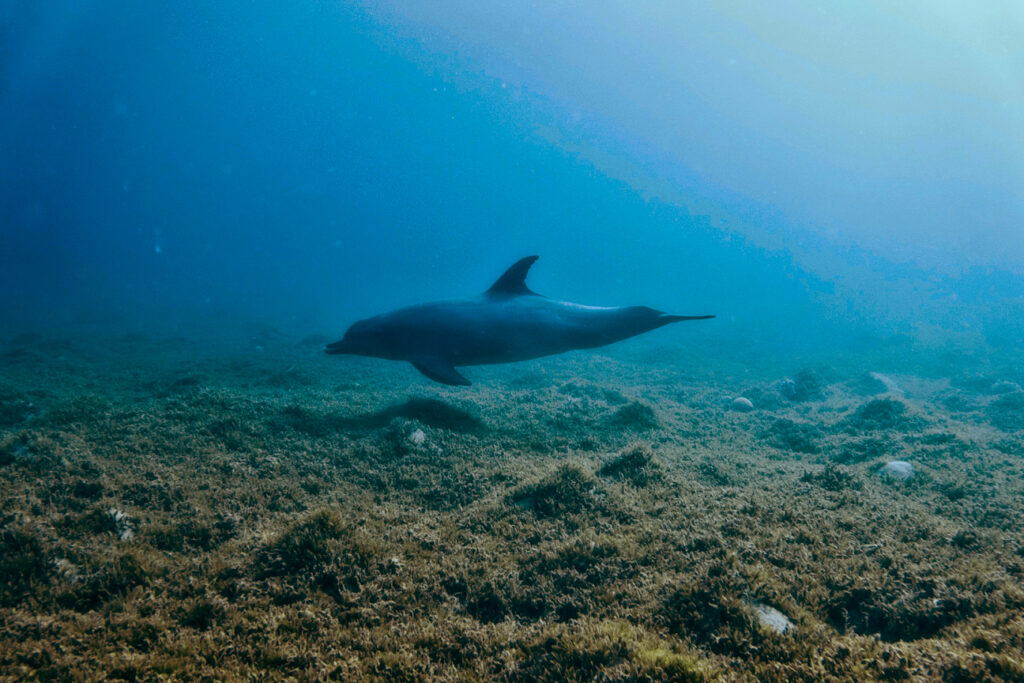
Why are seagrasses so important for us?
Seagrasses help us in the fight against climate change. You might wonder how?- Seagrasses need carbon dioxide, a gas in our air and in the seawater, to make their own food (a process called photosynthesis). Carbon dioxide is one of the gases that makes our earth getting warmer and warmer each year. Seagrasses are even able to take up as much carbon dioxide as all cars in Italy and France pump out in our air every year. That means that these great plants help us to slow down the warming of our earth and in this way help us to fight climate change.
Many animal species that we humans eat, need seagrass meadows to survive. Animals lay their eggs in seagrass meadows. Small baby fishes can hide between the seagrass blades and grow up protected by them. You can find 30 times as many animals within seagrass meadows than in the bare sandy areas next to them.
Three billion people get their food from seagrass meadows. So, on the whole world if you have groups of 3 persons, 1 of them is dependent on getting their food from seagrass meadows.
Seagrasses also protect our coasts. Their forest of leaves slows down huge waves. Their roots stabilize the sediment in which they grow and thereby prevent that our beaches are swallowed by the sea.
Moreover, seagrasses filter bacteria out of the water that could make us sick. Their forest of leaves also traps particles that float within the water. In this way seagrass meadows prevent that waters close to our coasts become a murky soup and help to keep our waters clear.
Why are more and more seagrass meadows disappearing?
We humans are the main reasons why more and more seagrass meadows are disappearing. One reason is climate change and global warming. The earth and with it also the ocean are warming up faster and more intensively than ever before. Have you ever been in a car in the
summer time? It was really hot when you were driving under the sun with no air conditioning and windows closed, right? This is because the windows let the sunlight in, but trap the heat in your car. This is how global warming works. The sun hits the earth and the heat wants to get out again, but there are certain gases in our air (like carbon dioxide or methane), that keep this heat trapped on earth and prevent it from going back into space again. We humans bring more and more of this gas carbon dioxide through, cars, air planes and factories into our air. That’s why it got 1°C warmer on earth in the last 100 years. It doesn’t sound like a big deal- only 1°C…but think about when you are having a fever, you feel really bad, right? But you are also only 1-3°C warmer than you usually would be. As bad and exhausted as you are feeling with a fever, this is exactly how seagrasses are feeling when the ocean will warm up further.
Another reason why seagrass meadows are dying is the pollution of the ocean.
Nutrients (like fertilizer or cow dung) are being flushed from fields on which our vegetables are grown or cows are feeding into the sea. On top of that, some countries will pump out everything you flush down the toilet directly into the ocean. Those nutrients will be eaten by algae which then get big and strong and grow onto and over the seagrass leaves. Moreover, tiny algae that are floating free in the water will also feast from those nutrients. Those tiny algae will grow as well and get so many that they are turning the clear blue water green. The sunlight can not reach anymore down to the seagrasses and they are not able to make their own food (since they need the sunlight for that) and will die slowly.

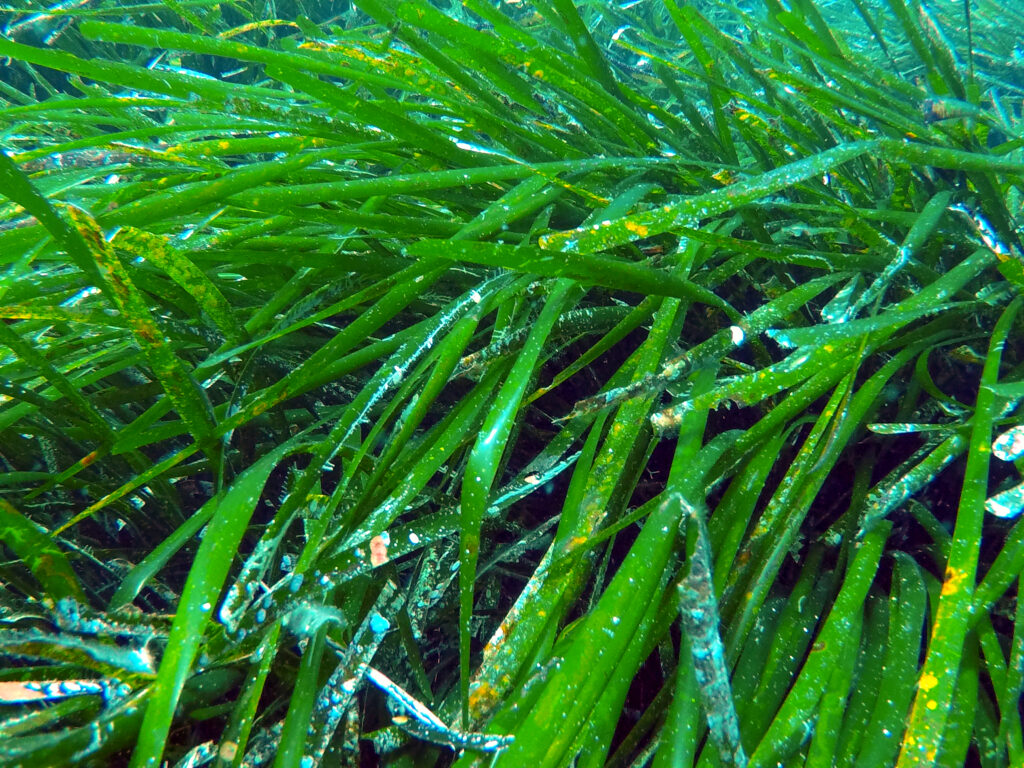
Right now, we lose one soccer fields of seagrass meadows every hour. Just imagine that! This happens every day, every hour. Seagrass meadows the size of one soccer field just disappear.
That’s why seagrass meadows need small heroes- just like you could be!
Fun facts from our book
- All seagrasses belong to the flowering plants (they are not algae!) and their next relatives on land are lilies- beautiful and colourful flowers. Seagrasses are the only flowering plants that can grow in the ocean.
- Seagrasses evolved from plants here on land. They adapted and returned to the marine environment around 100-140 million years ago. So their ancestors could be still found on land at times of the dinosaurs.
- Dolphins really use seagrasses, sargassum or algae to try to impress their Dolphin lady.
- The pollution of the ocean is next to global warming one of the main reasons why seagrass meadows are disappearing. Nutrients that are flushed into the sea get eaten by algae that are proliferating explosively and overgrow the leaves of the seagrass plants. Moreover, tiny algae (phytoplankton), which float freely in the water, are taken up the additional nutrients. They in turn will multiply intensively and in doing so turning the water green. The sunlight cannot reach anymore through this murky soup the seagrass leaves. As a consequence, the seagrasses are not able to photosynthesize (their form of food intake) any longer and will slowly die.
- Seagrass seeds can really be planted in small flower pots and grown in seawater aquaria to small plants that can then later be planted into the sea. This is what our colleague and friend Dr. Fay Belshe did during her ROOTSEA project at the Leibniz Centre for Marine Tropical Research (ZMT).
